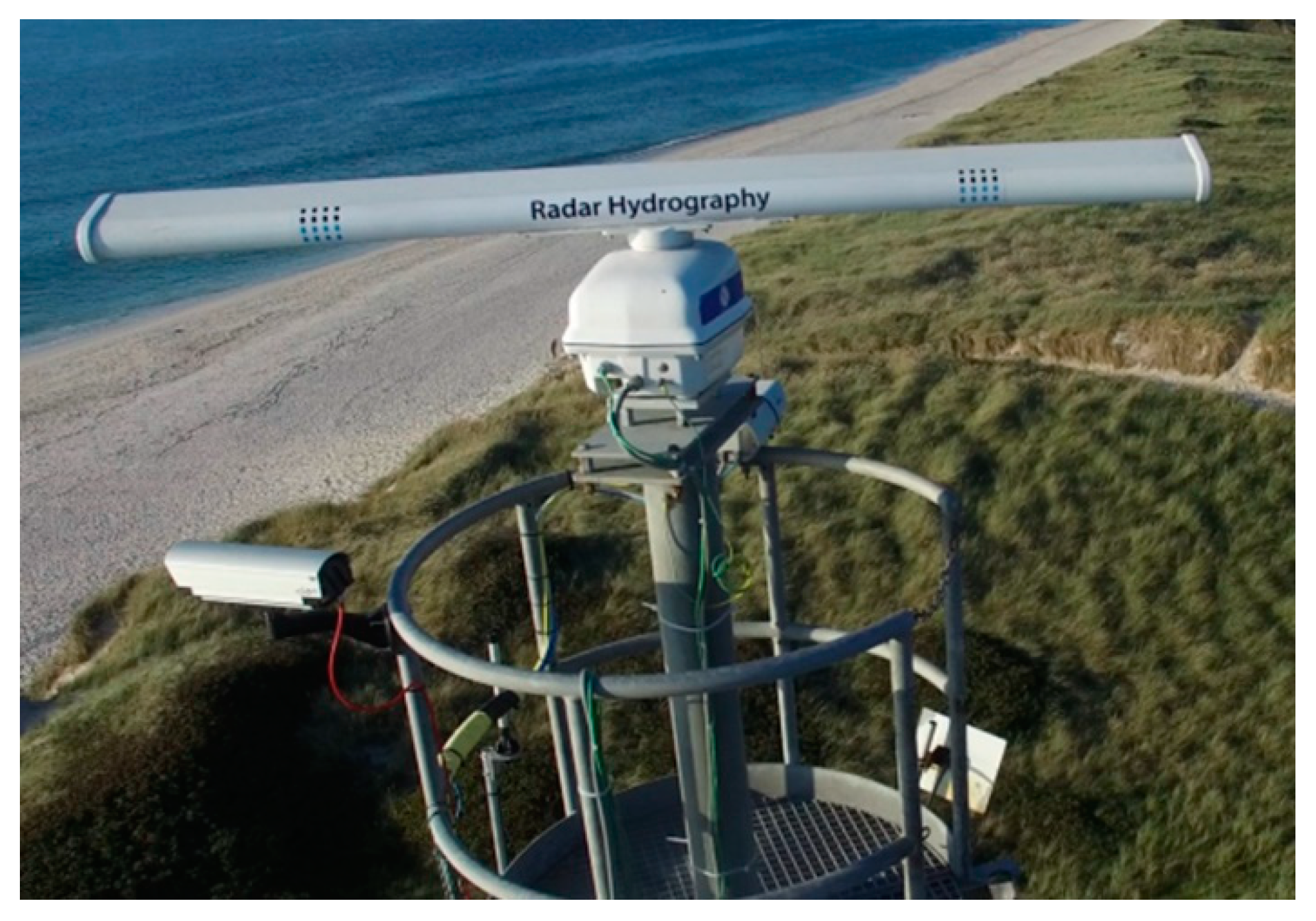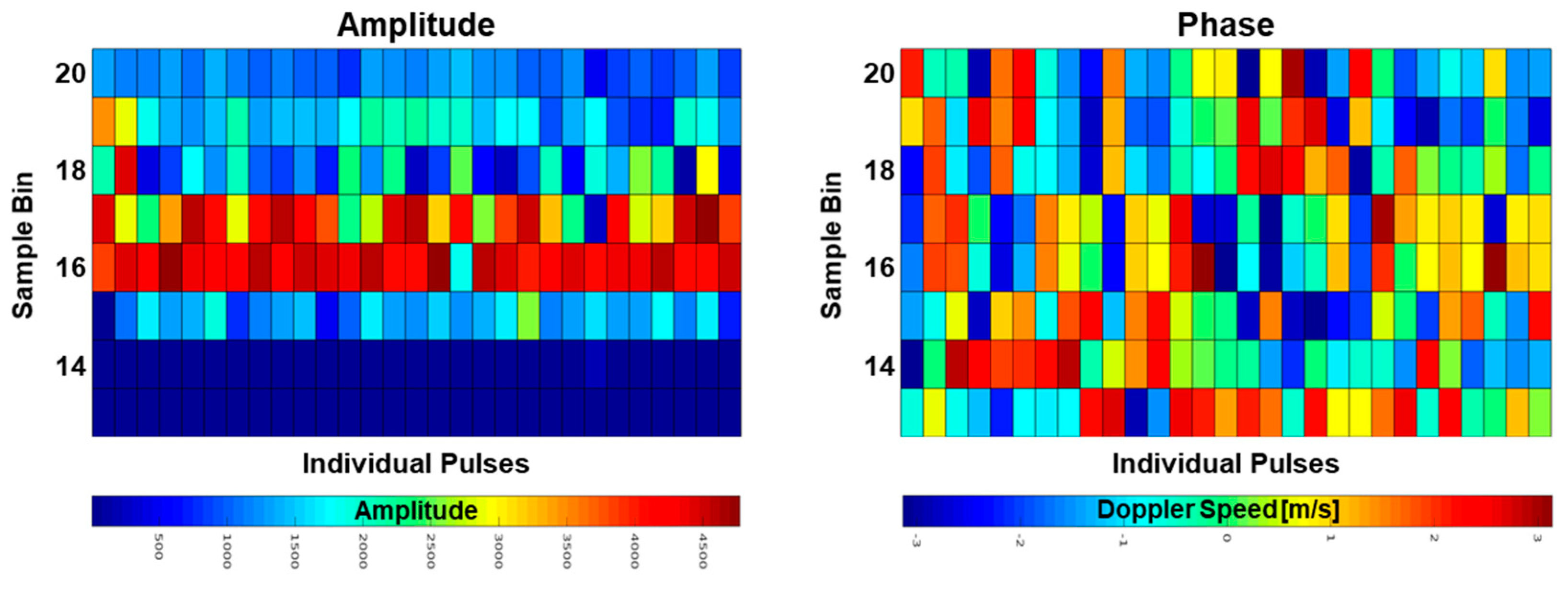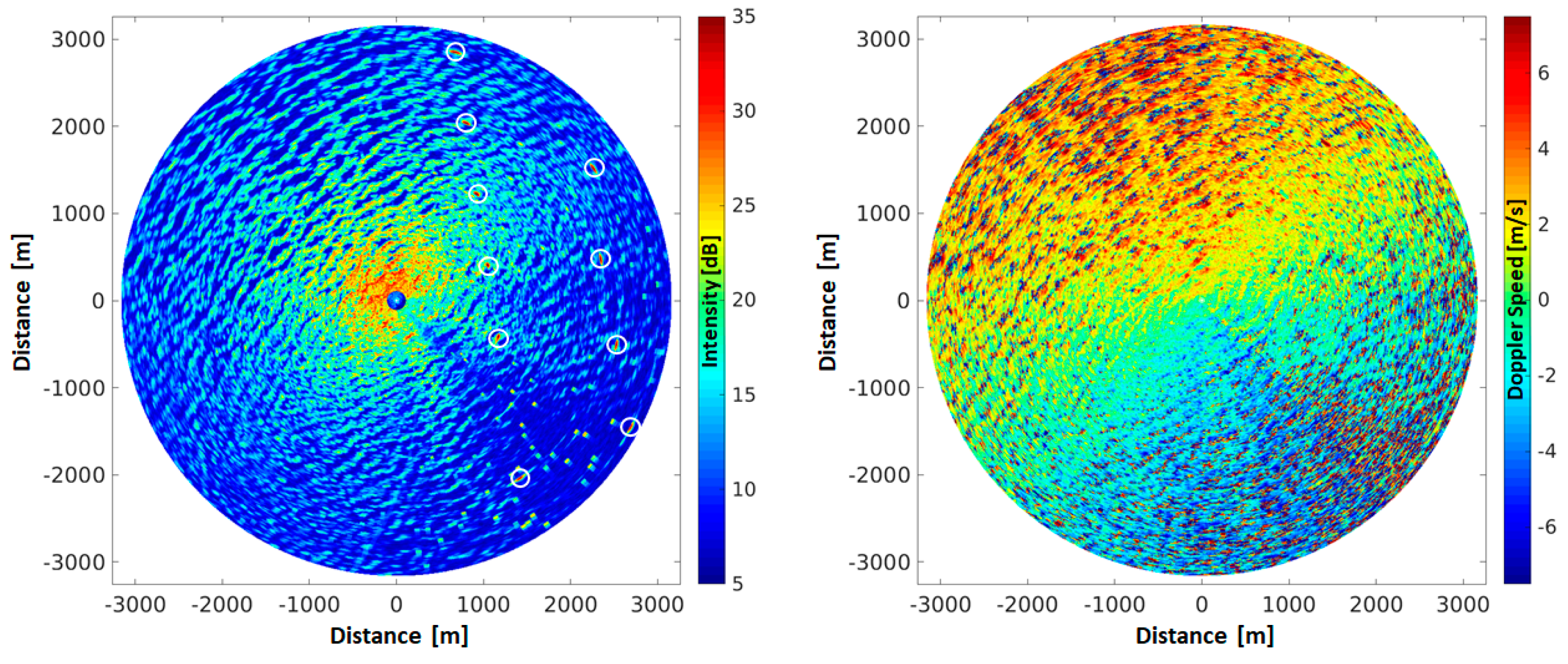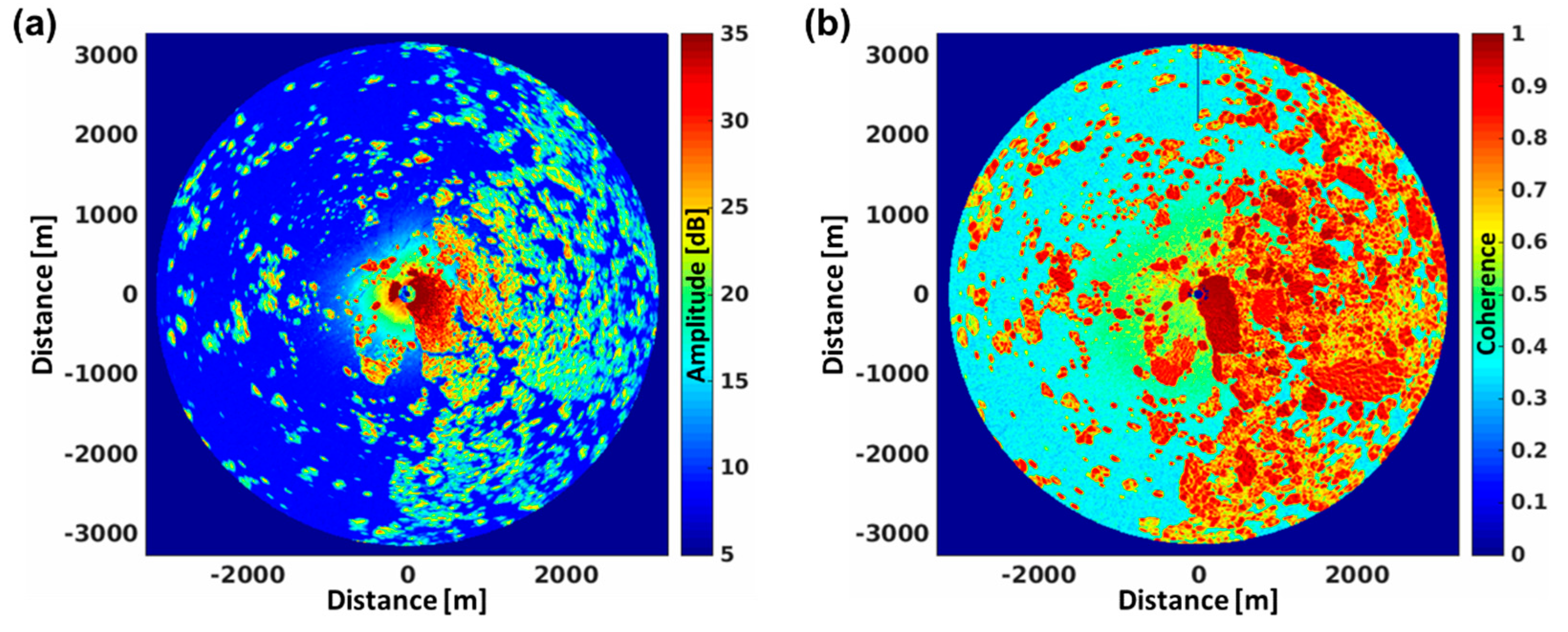A Coherent on Receive X-Band Marine Radar for Ocean Observations
Abstract
:1. Introduction
2. Description of Radar Hardware
3. Signal Tuning and Processing
3.1. Adjustment of Pulse Length
3.2. Estimation of Internal Time Delay
3.3. Fine Tuning of the Intermediate Frequency
3.4. Backscatter Intensity and Doppler Speed
4. Measurement Results
5. Conclusions and Outlook
Author Contributions
Funding
Acknowledgments
Conflicts of Interest
References
- Horstmann, J.; Borge, J.C.N.; Seemann, J.; Carrasco, R.; Lund, B. Wave and Current Retrieval Utilizing X-Band Marine Radars. In Coastal Ocean Observing Systems; Elsevier: Amsterdam, The Netherlands, 2015; Chapter 16; pp. 281–304. [Google Scholar]
- Huang, W.; Liu, X.; Gill, E.W. Ocean Wind and Wave Measurements Using X-Band Marine Radar: A Comprehensive Review. Remote Sens. 2017, 9, 1261. [Google Scholar] [CrossRef] [Green Version]
- Brown, G.S. Low-Grazing-Angle Backscatter from Rough Surfaces. IEEE Trans. Ant. Prop. 1998, 46, 114–120. [Google Scholar] [CrossRef]
- Dankert, H.; Horstmann, J.; Rosenthal, W. Ocean Wind Fields Retrieved from Radar-Image Sequences. J. Geophys. Res. Space Phys. 2003, 108, jc002056. [Google Scholar] [CrossRef]
- Vicen-Bueno, R.; Horstmann, J.; Terril, E.; De Paolo, T.; Dannenberg, J. Real-Time Ocean Wind Vector Retrieval from Marine Radar Image Sequences Acquired at Grazing Angle. J. Atmos. Ocean. Technol. 2013, 30, 127–139. [Google Scholar] [CrossRef]
- Borge, J.C.N.; Reichert, K.; Dittmer, J. Use of Nautical Radar as a Wave Monitoring Instrument. Coast. Eng. 1999, 37, 331–342. [Google Scholar] [CrossRef]
- Carrasco, R.; Horstmann, J.; Seemann, J. Significant Wave Height Measured by Coherent X-Band Radar. IEEE Trans. Geosci. Remote Sens. 2017, 55, 5355–5365. [Google Scholar] [CrossRef]
- Senet, C.; Seemann, J.; Ziemer, F. The Near-Surface Current Velocity Determined from Image Sequences of the Sea Surface. IEEE Trans. Geosci. Remote Sens. 2001, 39, 492–505. [Google Scholar] [CrossRef]
- Lund, B.; Haus, B.K.; Horstmann, J.; Graber, H.C.; Carrasco, R.; Laxague, N.J.M.; Novelli, G.; Guigand, C.M.; Özgökmen, T. Near-Surface Current Mapping by Shipboard Marine X-band Radar: A Validation. J. Atmos. Oceanic Technol. 2018, 35, 1077–1090. [Google Scholar] [CrossRef]
- Hatten, H.; Seemann, J.; Bezuglov, A.; Veremjev, V.; Ziemer, F. Determination of the Sea Surface Current Field from the Doppler Shift, of the Coherent Radar Backscatter with Grazing Incidence. In Proceedings of the OCEANS 2000 MTS/IEEE Conference and Exhibition, Providence, RI, USA, 11–14 September 2000; Volume 1, pp. 549–553. [Google Scholar] [CrossRef]
- Cysewski, M.; Seemann, J.; Ziemer, F. Sea Surface Current Mapping by Radar Doppler Current Profiler. In Proceedings of the IEEE Conference and Exhibition OCEANS, Sydney, Australia, 24–27 May 2010. [Google Scholar] [CrossRef]
- Nyman, L.; Lund, B.; Graber, H.; Romeiser, R.; Horstmann, J. Radar Observations of Ocean Surface Features Resulting from Underwater Topography Changes. Oceanography 2019, 32, 174–183. [Google Scholar] [CrossRef]
- Trizna, D.B. Comparisons of a Fully Coherent and Coherent-On-Receive Marine Radar for Measurements of Wave Spectra and Surface Currents. In Proceedings of the OCEANS 2010 MTS/IEEE Conference, Seattle, WA, USA, 20 September 2010; pp. 1–5. [Google Scholar] [CrossRef]
- Hwang, P.A.; Sletten, M.A.; Toporkov, J.V. A Note on Doppler Processing of Coherent Radar Backscatter from the Water Surface: With Application to Ocean Surface Wave Measurements. J. Geophys. Res. Space Phys. 2010, 115, jc005870. [Google Scholar] [CrossRef] [Green Version]
- Ermoshkin, A.V.; Kapustin, I.A. Estimation of the Wind-Driven Wave Spectrum using a High Spatial Resolution Coherent Radar. Russ. J. Earth Sci. 2019, 19, es000662. [Google Scholar] [CrossRef] [Green Version]
- Keeler, R.J.; Serafin, R.J. Meteorological Radar. In Radar Handbook, 3rd ed.; Skolnik, M.I., Ed.; MC Graw Hill: New York, NY, USA, 2008. [Google Scholar]
- Jordan, G.B. Comparison of Two Major Classes of Coherent Pulsed Radar Systems. IEEE Trans. Aerosp. Electron. Syst. 1975, 11, 363–371. [Google Scholar] [CrossRef]
- Benham, F.C.; Groginsky, H.L.; Soltes, A.S.; Works, G. Pulse Pair Estimation of Doppler Spectrum Parameters; Technical Report; Raytheon Company: Wayland, MI, USA, 1972. [Google Scholar]
- Miller, K.S.; Rochwarger, M.M. A Covariance Approach to Spectral Moment Eestimation. IEEE Trans. Inf. Theory 1972, 18, 588–596. [Google Scholar] [CrossRef]
- Valenzuela, G.R.; Laing, M.B. Study of Doppler Spectra of Radar Sea Echo. J. Geophys. Res. 1970, 75, 551–563. [Google Scholar] [CrossRef] [Green Version]
- Trizna, D. A model for Doppler Peak Spectral Shift for Low Grazing Angle Sea Scatter. IEEE J. Ocean. Eng. 1985, 10, 368–375. [Google Scholar] [CrossRef]
- Braun, N.; Ziemer, F.; Bezuglov, A.; Cysewski, M.; Schymura, G. Sea-Surface Current Features Observed by Doppler Radar. IEEE Trans. Geosci. Remote Sens. 2008, 46, 1125–1133. [Google Scholar] [CrossRef]
- Smith, G.E.; Majurec, N.; O’Brien, A.; Pozderac, J.; Baker, J.C.; Johnson, J.T.; Lyzenga, D.R.; Trizna, D.B.; Rudolf, D.; Nwuogu, O.; et al. High Power Coherent-On-Receive Radar for Marine Surveillance. In Proceedings of the 2013 International Conference on Radar, Adelaide, Australia, 9–12 September 2013; pp. 434–439. [Google Scholar] [CrossRef]
- Carrasco, R.; Streßer, M.; Horstmann, J. A Simple Method for Retrieving Significant Wave Height from Dopplerized X-Band Radar. Ocean Sci. 2017, 13, 95–103. [Google Scholar] [CrossRef] [Green Version]
- Støle-Hentschel, S.; Seemann, J.; Borge, J.C.N.; Trulsen, K. Consistency between Sea Surface Reconstructions from Nautical X-Band Radar Doppler and Amplitude Measurements. J. Atmos. Ocean. Technol. 2018, 35, 1201–1220. [Google Scholar] [CrossRef]
- Streβer, M.; Horstmann, J. Remote Quantification of Nearshore Wave Energy Dissipation Rates from Coherent X-Band Radar Backscatter. In Proceedings of the IEEE/OES Twelfth Current, Waves and Turbulence Measurement (CWTM), San Diego, CA, USA, 10–13 March 2019; pp. 1–6. [Google Scholar]
- Streβer, M.; Seemann, J.; Carrasco, R.; Cysewski, M.; Horstmann, J.; Baschek, B.; Deane, G. On the Interpretation of Coherent Marine Radar Backscatter from Surf Zone Waves. IEEE Trans. Geosci. Remote Sens. 2021. [Google Scholar] [CrossRef]
- Park, B.-K.; Yamada, S.; Lubecke, V. Measurement Method for Imbalance Factors in Direct-Conversion Quadrature Radar Systems. IEEE Microw. Wirel. Compon. Lett. 2007, 17, 403–405. [Google Scholar] [CrossRef]
- Alpers, W.R.; Ross, D.B.; Rufenach, C.L. On the Detectability of Ocean Surface Waves by Real and Synthetic Aperture Radar. J. Geophys. Res. Space Phys. 1981, 86, 6481–6498. [Google Scholar] [CrossRef]
- Hatten, H.; Seemann, J.; Horstmann, J.; Ziemer, F. Azimuthal Dependence of the Radar Cross Section and the Spectral Background Noise of a Nautical Radar at Grazing Incidence. In Proceedings of the International Geoscience and Remote Sensing Symposium (Cat. No.98CH36174), Seattle, WA, USA, 6–10 July 1998; Volume 5, pp. 2490–2492. [Google Scholar] [CrossRef]
- Dankert, H.; Horstmann, J. A Marine Radar Wind Sensor. J. Atmos. Ocean. Technol. 2007, 24, 1629–1642. [Google Scholar] [CrossRef]
- Plant, W.J.; Farquharson, G. Wave Shadowing and Modulation of Microwave Backscatter from the Ocean. J. Geophys. Res. Space Phys. 2012, 117, jc007912. [Google Scholar] [CrossRef] [Green Version]
- Lee, P.H.Y.; Barter, J.D.; Beach, K.L.; Hindman, C.L.; Lake, B.M.; Rungaldier, H.; Shelton, J.C.; Williams, A.B.; Yee, R.; Yuen, H.C. X Band Microwave Backscattering from Ocean Waves. J. Geophys. Res. Space Phys. 1995, 100, 2591–2611. [Google Scholar] [CrossRef]
- Farquharson, G.; Frasier, S.; Raubenheimer, B.; Elgar, S. Microwave Radar Cross Sections and Doppler Velocities Measured in the Surf Zone. J. Geophys. Res. Space Phys. 2005, 110, jc003022. [Google Scholar] [CrossRef] [Green Version]
- Catalán, P.A.; Haller, M.C.; Plant, W.J. Microwave Backscattering from Surf Zone Waves. J. Geophys. Res. Ocean. 2014, 119, 3098–3120. [Google Scholar] [CrossRef]
- Thompson, D.R.; Horstmann, J.; Mouche, A.; Winstead, N.S.; Sterner, R.E.; Monaldo, F.M. Comparison of High-Resolution Wind Fields Extracted from TerraSAR-X SAR Imagery with Predictions from the WRF Mesoscale Model. J. Geophys. Res. 2012, 117, 17. [Google Scholar] [CrossRef] [Green Version]
- Wang, Y.; Zhang, Y.; He, M.; Zhao, C. Doppler Spectra of Microwave Scattering Fields from Nonlinear Oceanic Surface at Moderate- and Low-Grazing Angles. IEEE Trans. Geosci. Remote Sens. 2011, 50, 1104–1116. [Google Scholar] [CrossRef]
- Miret, D.; Soriano, G.; Nouguier, F.; Forget, P.; Saillard, M.; Guerin, C.-A. Sea Surface Microwave Scattering at Extreme Grazing Angle: Numerical Investigation of the Doppler Shift. IEEE Trans. Geosci. Remote Sens. 2014, 52, 7120–7129. [Google Scholar] [CrossRef] [Green Version]
- Mv, R.; Jones, J.; Eicken, H.; Kambhamettu, C. Extracting Quantitative Information on Coastal Ice Dynamics and Ice Hazard Events From Marine Radar Digital Imagery. IEEE Trans. Geosci. Remote Sens. 2012, 51, 2556–2570. [Google Scholar] [CrossRef]










| Peak Power (nominal) | 12 kW |
| Transmit frequency | 9410 ± 30 MHz |
| Pulse width | 60 ± 20 ns |
| Pulse repetition frequency | 2 or 1 kHz |
| Intermediate frequency | 60 ± 2 MHz |
| Intermediate frequency bandwidth | 20 MHz with ±10% tolerance |
| Noise figure (radar front end) | Nominal 3.5 dB |
| Antenna rotation speed | up to 36 rpm |
| Linear amplification | 30 to 40 dB |
| Digitization frequency | 80 MHz, 2 channel with 14 bit |
| Angular transmitter resolution | 0.012 |
| Length | 4′ | 7.5′ | 9′ |
|---|---|---|---|
| Horizontal beamwidth | 1.8° ± 0.1° | 1.2° ± 0.1° | 0.85° ± 0.1° |
| Vertical beamwidth | 22° ± 2° | 22° ± 2° | 22° ± 2° |
| Sidelobes within ±10° | −26 dB | −25 dB | −24 dB |
| Sidelobes outside ±10° | −30 dB | −30 dB | −30 dB |
| Gain | ≥27 dBi | ≥30 dBi | ≥31 dBi |
Publisher’s Note: MDPI stays neutral with regard to jurisdictional claims in published maps and institutional affiliations. |
© 2021 by the authors. Licensee MDPI, Basel, Switzerland. This article is an open access article distributed under the terms and conditions of the Creative Commons Attribution (CC BY) license (https://creativecommons.org/licenses/by/4.0/).
Share and Cite
Horstmann, J.; Bödewadt, J.; Carrasco, R.; Cysewski, M.; Seemann, J.; Streβer, M. A Coherent on Receive X-Band Marine Radar for Ocean Observations. Sensors 2021, 21, 7828. https://doi.org/10.3390/s21237828
Horstmann J, Bödewadt J, Carrasco R, Cysewski M, Seemann J, Streβer M. A Coherent on Receive X-Band Marine Radar for Ocean Observations. Sensors. 2021; 21(23):7828. https://doi.org/10.3390/s21237828
Chicago/Turabian StyleHorstmann, Jochen, Jan Bödewadt, Ruben Carrasco, Marius Cysewski, Jörg Seemann, and Michael Streβer. 2021. "A Coherent on Receive X-Band Marine Radar for Ocean Observations" Sensors 21, no. 23: 7828. https://doi.org/10.3390/s21237828
APA StyleHorstmann, J., Bödewadt, J., Carrasco, R., Cysewski, M., Seemann, J., & Streβer, M. (2021). A Coherent on Receive X-Band Marine Radar for Ocean Observations. Sensors, 21(23), 7828. https://doi.org/10.3390/s21237828







